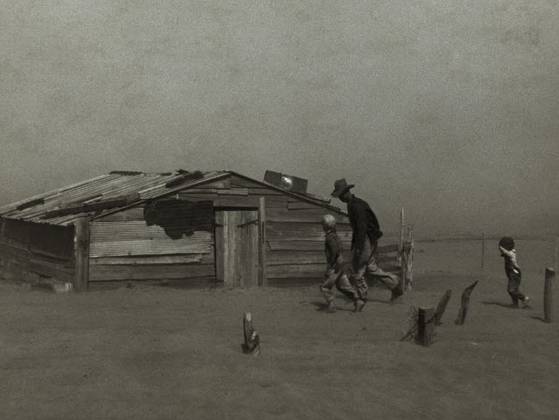 There were spools of dramatic period newsreel film to fill Ken Burns four-hour, two night documentary on “The Dust Bowl,” which begins tonight on PBS. All of it, it seems, was in black and white. Which was fitting, as the big black clouds, hundreds of miles long, a mile or two high, rolled across the plains, bringing a midnight darkness to noontime.
There were spools of dramatic period newsreel film to fill Ken Burns four-hour, two night documentary on “The Dust Bowl,” which begins tonight on PBS. All of it, it seems, was in black and white. Which was fitting, as the big black clouds, hundreds of miles long, a mile or two high, rolled across the plains, bringing a midnight darkness to noontime.
But how, I wondered, did they replicate the sound of that fearsome era? There were no audio recordings made of it, so Burns and his team had to be creative.
“This is one of the most complex sound effects we’ve had with literally dozens and dozens of tracks, and it’s us experimenting with different wind sounds, and more often than not, any wind dynamic is just that, several winds that we’ve put together and tried to give it shape and form,” Burns says.
“This is a hugely complex bringing to life of silent stuff, which is what we’ve been doing, you know, since the very beginning,” Burns days.
Besides combining wind sounds, he adds, “we would get panes of glass and throw sand at it … to try to replicate what we heard from the collective testimony” of those they had interviewed.
One of the strengths of the documentary is not just the footage, but the interviews with several oldtimers who recall the awful storms of 1932-35 as if it were yesterday.
One of them was Calvin Crabill, who accompanied Burns to the TV Critics summer press tour in July to discuss the film, and his memories in that same plainspoken way.
“On the plains, often there’s a sound,” Crabill said. “You sense the wind because the wind blows so much there. But what was so awesome is that, suddenly, you had silence on the plains, silence, almost deafening silence. And then when ‑‑ they call them ‘rollers.’ When that roller hit, all hell broke loose. It was deafening… you couldn’t see or hear.”
There are amazing stories far beyond the usual “Grapes of Wrath” things people know about the storm, including the hoardes of jackrabbits that invaded the dusty land, and the storms that pushed east far enough to bring dust clouds to Central Park, and even to ships 300 miles out in the Atlantic Ocean.
The Dust Bowl was one of the worst man-made environmental disasters, with the rapid explosion of cultivating buffalo grasses into wheat first for World War I and then to make up for losses of dropping crop prices depleted the soil. Add that to the draught that happened then, similar to the one that happened this year and you’ve got a history lesson that is also a cautionary tale, roaring in your ears.
“The Dust Bowl” begins tonight at 8 p.m. on PBS and concludes Monday at 8 p.m.